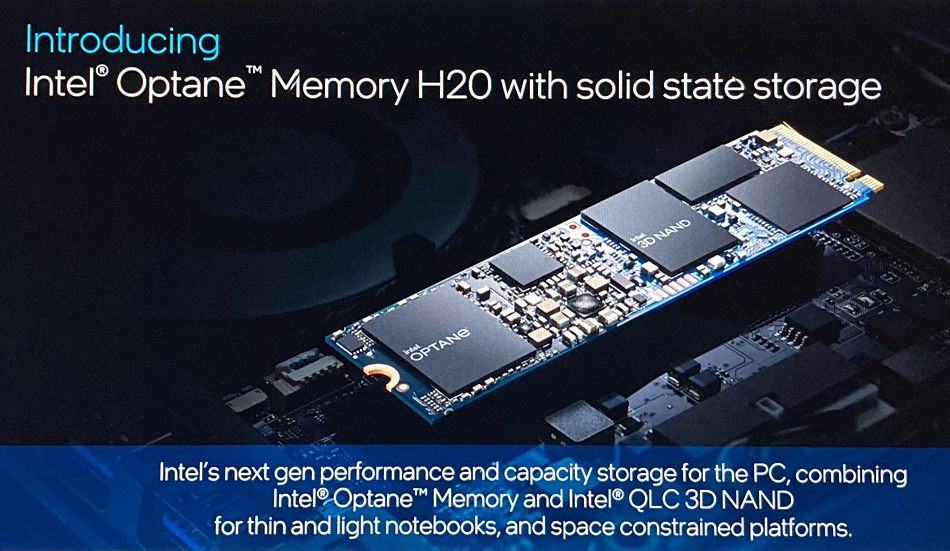Intel has launched three new Optane drives, all faster than their predecessors, including one it dubs “the world’s fastest data centre SSD”.
Speaking at the Intel Memory and Storage Moment event yesterday, David Tuhy, GM of Intel’s Optane storage division called the new P5800X enterprise SSD “a stunning, stunning product”.
Intel produces client and data centre SSDs and data centre memory Optane products and its three launches, the H20, P5800X and Persistent Memory 200 Series (PMem 200), slot respectively in to each product category.
All three new drives use gen 2 3D XPoint technology, which incorporate a new controller and four decks of cells, compared with two decks in gen 1, to achieve significant latency and performance gains over their predecessors.
We have positioned them in an Optane product table, along with rumoured future products that we will discuss below.

H20
The H20 is a single-side M.2 gumstick format drive for thin and light notebooks, and follows on from the current H10. It pairs a 32GB slug of gen 2 3D Optane with a much larger lump of QLC 3D NAND, 144-layer in this case. Intel’s RST technology puts fast access data in the Optane cache and other data in the NAND.

The H20 will be supported by the upcoming 11th gen Intel Core U series processor and 500 Series chipset. It comes in 512GB and 1TB capacities, uses the PCIe 3.0 and should ship in the second 2021. Intel did not reveal performance details but said faster PCIe Gen 4 bandwidth is not needed for the use cases it is pursuing. The H10 has 256GB, 512GB and 1TB capacities – which means the 256GB variant is being dropped.
P5800X
The U.2 format P5800X drive, formerly known as Alder Stream, is a successor to the P4800X. Intel has disclosed a ton of performance data for the “world’s fastest data centre SSD”. The drive uses both gen 2 3DXP and the PCIe 4.0 bus to handle up to 1.5 million random read or write IOPS and up to 7.2GB/sec sequential read and 6.2GB/sec sequential write bandwidth. It also lives longer than the P4800X.

For comparison the P4800X drive delivers 550,000/500,000 random read/write IOPS and sequential read/write bandwidth is up to 2.4/2.0 GB/sec; Also the P4800 endurance is 60 drive writes per day (DWPD) for five years which is 60 per cent of the P5800X’s endurance. Coincidentally, the P5800X’s latency of <6μs is 60 per cent that of the P4800X.
P5800X capacity points are 400GB, 800GB, 1.6TB and 3.2TB. For reference the P4800X comes in 375GB, 750GB, and 1.5TB capacities. It should ship the first 2021 quarter.
Persistent Memory 200 Series
The Optane PMem 200, revealed in June and known as Barlow Pass, is 3DXP delivered in a DIMM form factor and connects to a CPU via the memory bus, not the PCIe bus. Latency is in the 100ns to 340ns area, which is more than a thousand times faster than the P5800X (1μs equals 1,000ns).

The PMem 200 goes up to 25 per faster in memory bandwidth terms than the current PMem 100. Application performance is improved by a utility, called eADR (enhanced Asynchronous DRAM refresh) that automates flushing of the cache in the event of a power failure. That means there is no waiting for a flush to complete as with the current product. Applications with mapped data in PMem will benefit from this.
There is the same 6TB total memory per CPU socket as the PMem 100, and the PMem 200 comes with the same Memory Mode and App Direct Mode access methods as the PMem 100. It should ship next quarter.
Future Optanes
Intel said at yesterday’s event it is planning two more 3DXP generations but did not discuss details. However, a leaked vendor presentation currently circulating the internet reveals Intel is developing a PMem product known as Crow Pass. This will support PCIe 5.0 and will require the upcoming Sapphire Rapids Xeon CPUs.

After that a fourth generation, code-named Donahue Pass, will be paired with Intel’s Granite Rapids CPU. We have no further details, apart from suspecting that gen 3 may use a doubled deck count, with gen 4 doubling the count again.








